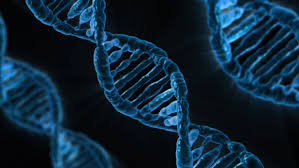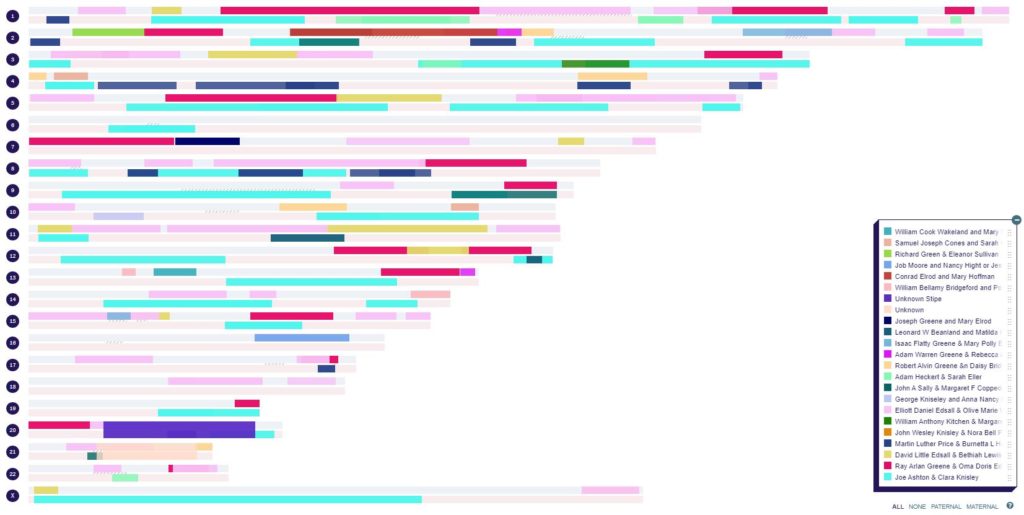What is chromosome mapping?
Chromosome mapping is a nifty tool that paints DNA segments on a map of your chromosomes. Using your DNA test data, chromosome mapping graphically shows how you connect to your ancestors (1, 3). This technique shows which ancestor provided you with a specific segment of DNA (2). Also called segment mapping or ancestor mapping, the process is not hard and can have the benefit of being a family project.
What can a chromosome map be used for?
A chromosome map is more than a pretty picture. This technique can be used for:
- Tracking cousin matches and how they relate to you
- Mapping an ancestor’s contribution to your DNA
- Analyzing DNA from cousins that you don’t know
- Verifying inheritance paths
- Generating interest in genealogy as a family project
- Guiding further research
How do I get started?
DNAPainter.com provides instructions for importing your data from the various testing companies and GEDMatch.com. Once you download the test results, DNA Painter will paint the segments above 7cM (or another specified size) to your chromosome map and prompts you to name the common ancestor that you share with that specific cousin. You can also paint cousins that you have not been able to find the common match but start with those cousins that you know the connection first. If you want more information you can watch the video at: https://familytreewebinars.com/download.php?webinar_id=955 (1).
Data that can be included in your chromosome map is limited to the detailed data that is available from the testing platforms.

Chromosome mapping can use autosomal DNA test data from FTDNA, 23&Me, or MyHeritage, to assign DNA segments to specific chromosomes.
Did not test with one of these testing companies? Explore transferring your test results to FTDNA, My Heritage, or GEDMatch. You can also take an additional test with FTDNA, 23&Me or MyHeritage, each offering different products and focus.
Which Matches Should I Use?
Testing your parents is the best way to allocate the paternal and maternal chromosome segments. Testing your parents makes this process easier, but that is not always an option (2). You can create a chromosome map using only cousin matches. Start with cousins that you know, and you are confident you know the actual relationship. Data from multiple cousins on both the paternal and maternal sides will be needed to fill in the chromosomes. Mapping siblings, nephews or nieces is not useful, as it does not allow you to delineate the ancestral origins of the DNA.
Neither of my parents are alive to test, so my strategy was to use my test results with multiple cousins, from multiple test sites. To start, I used data from cousins that I knew how we were related. Next, I brought in cousins from testing platforms that provided family tree information that allowed me to predict my relationship to the cousin. To maximize coverage, I selected matches on both my maternal and paternal sides that had 15 cM or larger segments. While most systems will show matches based on smaller segments of DNA, these pieces may not be actual matching DNA. Genetic genealogists recommend segments of at least 10 cM, and preferably 15 cM to ensure that the segment is matching your DNA (2).
What Does a Chromosome Map Look Like?
Below is an example of a chromosome map that I developed using DNAPainter.com. While DNAPainter.com is not the only vendor that offers this type of service, the site allows an individual to construct one chromosome map for free. This enables you to experiment to see if the tool will work for you before paying for this service. In addition, DNApainter.com provides some other DNA tools that you may find useful (1).


I used the most recent common ancestor couple as the labeling system on my legend. The DNA segments for specific cousins that are copied from the testing platform are painted onto the corresponding chromosome. The segments are then labeled with the most recent common ancestor couple’s name. You can also paint segments from cousins for which the connection is unknown.
A closeup of Chromosome 8 shows matches on both the paternal (top DNA strand) and the maternal (lower DNA strand) that are color coded to the most recent common ancestor couple. You can designate whether the couple is on your maternal or paternal side and sort based on the those attributes.

Do I need to track which cousins I put into the chromosome map?
Yes, keep a table or spreadsheet of matches you input into your chromosome map; you may need the information for comparison (2). Detailed information about a segment can also allow you to compare data with cousins that you have not determine the connection and make an educated hypothesis that can be further researched.
My preference is a spreadsheet, so the matches can be sorted by various attributes, e.g., maternal or paternal lines, most recent common ancestor, etc. Below are the headers I use in my spreadsheet for tracking cousins I have put into my chromosome map. I also keep the actual data for each cousin from each testing system in a separate tab.

In Summary
Don’t be afraid of chromosome mapping. Yes, it can be time consuming, but the effort is well worth it. Keep track of your cousins that you include in the map, it will be beneficial at many points. If you need help, see the resources in the References section below. Or you can contact us for assistance and coaching. Reasonable rates apply.
References
- DNA Painter. Help and Advice. Accessed at https://dnapainter.com/ on 06 December 2019.
- International Society of Genetic Genealogy. Chromosome Mapping. Accessed at https://isogg.org/wiki/Chromosome_mapping on 06 December 2019.
- Wheaton Surname Resources. Lesson 12, Chromosome Mapping. Accessed at https://sites.google.com/site/wheatonsurname/beginners-guide-to-genetic-genealogy/lesson-12-if-you-have-made-it-this-far on 06 December 2019.

Leave a Reply